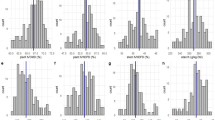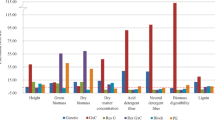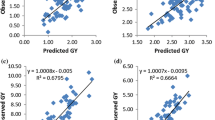Abstract
Crude protein (CP), neutral detergent fiber (NDF), acid detergent fiber (ADF), and mineral content are important components of forage quality in grasses. Elevated [K]/([Ca] + [Mg]) ratios (KRAT) substantially increase the risk of grass tetany (hypomagnesemia) in grazing animals, which is a serious problem associated with some cool-season grasses. The objectives of this study were to map and compare QTLs controlling concentrations of CP, NDF, ADF, Al, B, Ca, Cl, Cu, Fe, K, Mg, Mn, Na, P, S, Si, Zn, and KRAT in two full-sib Leymus triticoides × (L. triticoides × L. cinereus) TTC1 and TTC2 families. Significant genetic variation and QTLs were detected for all traits, with evidence of conserved QTLs for ADF (LG1a, LG5Xm, LG7a), NDF (LG7a), Ca (LG1b), CP, (LG5Xm), KRAT (LG3b, LG6b, LG7a, LG7b), Mn (LG2b, LG3b, LG4Xm), and S (LG3a) content in both TTC1 and TTC2 families. Moreover, the direction of QTL effects was the same for 13 of the 14 homologous QTLs in both families. The TTC1 and TTC2 KRAT QTLs on LG7a and LG7b were located near markers defining homoeologous relationships between the sub-genomes of allotetraploid Leymus, suggesting possible QTL homoeology. Another 88 QTLs were unique to one family or the other, but many of these clustered in genome regions common between the two families. These results will support development of new Leymus wildrye forages and help characterize genes controlling mineral uptake and fiber synthesis.




Similar content being viewed by others
Abbreviations
- ADF:
-
acid detergent fiber
- CP:
-
crude protein
- KRAT:
-
K/(Ca + Mg) ratio
- NDF:
-
neutral detergent fiber
References
Asay KH, Jensen KB, Waldron BL, Han G, Johnson DA, Monaco TA (2002) Forage quality of tall fescue across an irrigation gradient. Agron J 94:1337–1343
Asay KH, Mayland HF (1990) Genetic variability for elements associated with grass tetany in Russian wildrye. J Range Manage 43:407–411
Asay KH, Mayland HF, Clark DH (1996) Response to selection for reduced grass tetany potential in crested wheatgrass. Crop Sci 36:895–900
Asay KH, Mayland HF, Jefferson PG, Berdahl JD, Karn JF, Waldron BL (2001) Parent-progeny relationships and genotype × environment effects for factors associated with grass tetany and forage quality in Russian wildrye. Crop Sci 41:1478–1484
Barrière Y, Laperche A, Barrot L, Aurel G, Briand M, Jouanin L (2005) QTL analysis of lignification and cell wall digestibility in the Bay-0 × Shahdara RIL progeny of Arabidopsis thaliana as a model system for forage plant. Plant Sci 168:1235–1245
Casler MD (2001) Breeding forage crops for increased nutritional value. Adv Agron 71:51–107
Casler MD, Vogel KP (1999) Accomplishments and impact from breeding for increased forage nutritional value. Crop Sci 39:12–20
Churchill GA, Doerge RW (1994) Empirical threshold values for quantitative trait mapping. Genetics 138:963–971
Cogan NOI, Smith KF, Yamada T, Fracki MG, Vecchies AC, Jones ES, Spangenberg GC, Forster JW (2005) QTL analysis and comparative genomics of herbage quality traits in perennial ryegrass (Lolium perenne L.). Theor Appl Genet 110:364–380
Dewey DR (1984) The genome system of classification as a guide to intergeneric hybridization with the perennial Triticeae. In: Gustafson JP (ed) Gene manipulation in plant improvement. Plenum Press, New York, pp 209–279
Falkner LK, Casler MD (1998) Preference for smooth bromegrass clones is affected by divergent selection for nutritive value. Crop Sci 38:690–695
Hides DH, Thomas TA (1981) Variation in the magnesium content of grasses and its improvement by selection. J Sci Food Agric 32:990–991
Holland JB, Nyquist WE, Cervantes-Marinez CT (2003) Estimating and interpreting heritability for plant breeding: an update. Plant Breed Rev 22:9–111
Hu ZM, Wu XL, Larson SR, Wang RRC, Jones TA, Chatterton NJ, Palazzo AJ (2005) Detection of linkage disequilibrium QTLs controlling low-temperature growth and metabolite accumulations in an admixed breeding population of Leymus wildryes. Euphytica 141:263–280
Jansen RC (1993) Interval mapping of multiple quantitative trait loci. Genetics 135:205–211
Jansen RC (1994) Controlling the type I and type II errors in mapping quantitative trait loci. Genetics 138: 871–881
Jansen RC, Stam P (1994) High resolution of quantitative traits into multiple loci via interval mapping. Genetics 136:447–1445
Jefferson PG, Mayland HF, Asay KH, Berdahl JD (2001) Variation in mineral concentration and grass tetany potential in Russian wildrye accessions. Crop Sci 41:543–548
Jefferson PG, McCaughey WP, May K, Woosaree J, MacFarlane L, Wright SMB (2002) Performance of American native grass cultivars in the Canadian Prairie Provinces. Native Plants J 3(1):24–33
Jensen KB, Johnson DA, Asay KH, Olson KC (2002) Seasonal-accumulated growth and forage quality of range grasses for fall and winter grazing. Can J Plant Sci 82:329–336
Jones ES, Mahoney NL, Hayward MD, Armstead IP, Jones JG, Humphreys MO, Kink IP, Kishida T, Yamada T, Balfourier F, Charmet C, Forster JW (2002) An enhanced molecular maker-based map of perennial ryegrass (Lolium perenne L.) reveals comparative relationships with other Poaceae species. Genome 45:282–295
Karn JF, Mayland HF, Berdahl JD, Asay KH, Jefferson PG (2005) Russian wildrye nutritive quality as affected by accession and environment. Can J Plant Sci 85:125–133
Krakowsky MD, Lee M, Coors JG (2005) Quantitative trait loci for cell wall components in recombinant inbred lines of maize (Zea mays L.) I: stalk tissue. Theor Appl Genet 111:337–346
Krakowsky MD, Lee M, Coors JG (2006) Quantitative trait loci for cell wall components in recombinant inbred lines of maize (Zea mays L.) II: leaf sheath tissue. Theor Appl Genet 112:717–726
Lander ES, Botstein D (1989) Mapping Mendelian factors underlying quantitative traits using RFLP linkage maps. Genetics 121:185–199
Larson SR, Wu XL, Jones TA, Jensen KB, Chatterton NJ, Waldron BL, Robins JG, Bushman BS, Palazzo AJ (2006) Comparative mapping of growth habit, plant height, and flowering QTLs in two interspecific families of Leymus. Crop Sci 46:2526–2539
Lawrence T, Winkleman GE, Warder FG (1982) The chemical composition of Russian and Altai wild ryegrass and crested wheatgrass as influenced by N fertilization and date of harvest. Can J Plant Sci 62:373–390
Lauriault LM, Kirsey RE, VanLeeuwen DM (2005) Performance of perennial cool-season forage grasses in diverse soil moisture environments, Southern High Plains, USA. Crop Sci 45:909–915
Löve A (1984) Conpectus of the Triticeae. Feddes Rep 95:425–521
Lidgett A, Jennings K, Johnson X, Guthridge K, Jones E, Spangenberg G (2002) Isolation and characterisation of a fructosyltransferase gene from perennial ryegrass (Lolium perenne). J Plan Phys 159:1037–1043
Lübberstedt T, Melchinger AE, Klein DK, Degenhardt H, Paul C (1997) QTL mapping in testcrosses of European flint lines of maize: II. Comparison of diffferent testers for forage quality traits. Crop Sci 37:1913–1922
Ma JF, Nagao S, Sato K, Ito H, Furukawa J, Takeda K (2004) Molecular mapping of a gene responsible for Al-activated secretion of citrate in barley. J Exp Bot 55:1335–1341
Magalhaes JV, Garvin DF, Wang Y, Sorrells ME, Klein PE, Schaffert RE, Li L, Kochian LV (2004) Comparative mapping of a major aluminum tolerance gene in sorghum and other species in the Poaceae. Genetics 167:1905–1914
Mayland HF (1988) Grass tetany. In: Church DC (ed) The Ruminant Animal, Digestive Physiology and Nnutrition. Prentice Hall, Englewood Cliffs, N.J. ISBN 0–8359-6782-4
Méchin V, Argillier O, Hérbert Y, Guingo E, Moreau L, Charcosset A, Barrière Y (2001) Genetic analysis and QTL mapping of cell wall digestibility and lignification in silage maize. Crop Sci 41:690–697
Mosely G, Baker DH (1991) The efficacy of a high magnesium grass cultivar in controlling hypomagnesemia in grazing animals. Grass Forage Sci 46:375–380
Raman H, Moroni JS, Sato K, Read BJ, Scott BJ (2002) Identification of AFLP and microsatellite markers linked with an aluminum tolerance gene in barley (Hordeum vulgare L.). Theor Appl Genet 105:458–646
Saiga S, Higashiyama M, Toyoda S, Shiga A (1992) Effect of orchardgrass (Dactylis glomerata L.) cultivars with different mineral levels on serum mineral concentrations in grazing sheep. J Jpn Soc Grassl Sci 38:294–301
Saiga S, Izumi K (1997) Comparison of X-ray microanalysis methods in screening mineral concentration for orchargrass (Dactylis glomerata L.) plants. Grassl Sci 43:18–33
Sleper DA, Mayland HF, Crawford RJ, Shewmaker GE, Massie MD (2002) Registration of HiMag tall fescue germplasm. Crop Sci 42:318–319
Sleper DA, Vogel KP, Asay KH, Mayland HF (1989) Using plant breeding and genetics to overcome the incidence of grass tetany. J Anim Sci 67:46–3462
Sun GL, Wu BH, Liu F (1995) Cytogenetic and genomic relationships of Thinopyrum elongatum with two Psathyrostachys species and with Leymus secalinus (Poacae). Plant Syst Evol 197:225–231
Tang Y, Sorrells ME, Kochian LV, Garvin DF (2000) Identification of RFLP markers linked to the barley aluminum tolerance gene Alp. Crop Sci 40:778–782
Van Ooijen JW (1992) Accuracy of mapping quantitative trait loci in autogamous species. Theor Appl Genet 84:803–811
Van Ooijen JW (1999) LOD significance thresholds for QTL analysis in experimental populations of diploid species. Heredity 83:613–624
Van Ooijen JW (2004) MapQTL ® 5, Software for the mapping of quantitative trait loci in experimental populations. Kyazma B.V., Wageningen Netherlands
Van Soest PJ (1994) Nutritional ecology of the ruminant, 2nd edn. Cornell Univ. Press, Ithica NY
Vogel KP, Mayland HF, Reece PE, Lamb JFS (1989) Genetic variability for mineral element concentration of crested wheatgrass forage. Crop Sci 29:1146–1150
Voorrips RE (2002) MapChart: software for the graphical presentation of linkage maps and QTLs. Heredity 93:77–78
Wang RRC, von Bothmer R, Dvorak J, Linde-Laursen I, Muramatsu M (1994) Genome symbols in the Triticeae (Poaceae). In: Wang RRC, Jensen KB, Jaussi C (eds) Proceedings of the 2nd international Triticeae symposium, Logan, Utah, June 1994. Utah State University Press, Logan, pp 29–31
Wei JZ, Chatterton NJ, Larson SR, Wang RRC (2000) Linkage mapping and nucleotide polymorphims of the 6-SFT gene of cool-season grasses. Genome 43:931–938
Wu XL, Larson SR, Hu ZM, Palazzo AJ, Jones TA, Wang RRC, Jensen KB, Chatterton NJ (2003) Molecular genetic linkage maps for allotetraploid Leymus (Triticeae). Genome 46:627–646
Zhang HQ, Dvořák J (1991) The genome origin of tetraploid species of Leymus (Poacea: Triticeae) inferred from variation in repeated nucleotide sequences. Am J Bot 78:871–884
Zhang HQ, Yang RW, Dou QW, Tsujimoto H, Zhou YH (2006) Genome constitutions of Hystrix patula, H. duthiei ssp. duthiei and H. duthiei ssp. longearistata (Poaceae: Triticeae) revealed by meiotic pairing behavior and genomic in-situe hybridization. Chromosome Res 14:595–604
Zhao Z, Ma JF, Sato K, Takeda K (2003) Differential Al resistance and citrate secretion in barley (Hordeum vulgare L.). Planta 217:794–800
Acknowledgements
This work was supported by joint contributions of the USDA Agriculture Research Service, Utah Agriculture Experiment Station, Department of Defense Strategic Environmental Research and Development Program CS1103 project, and US Army BT25-EC-B09 project (Genetic Characterization of Native Plants in Cold Regions). Trade names are included for the benefit of the reader, and imply no endorsement or preferential treatment of the products listed by the USDA.
Author information
Authors and Affiliations
Corresponding author
Rights and permissions
About this article
Cite this article
Larson, S.R., Mayland, H.F. Comparative mapping of fiber, protein, and mineral content QTLs in two interspecific Leymus wildrye full-sib families. Mol Breeding 20, 331–347 (2007). https://doi.org/10.1007/s11032-007-9095-9
Received:
Accepted:
Published:
Issue Date:
DOI: https://doi.org/10.1007/s11032-007-9095-9




